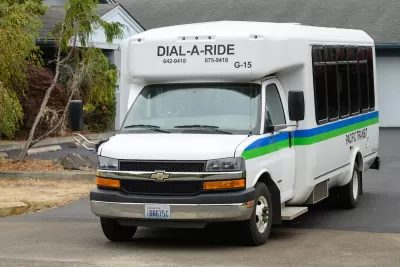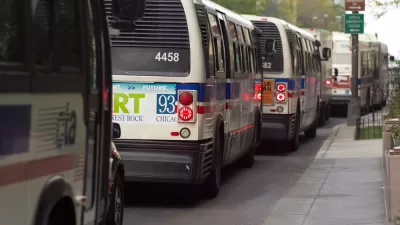On-demand services can’t scale successfully without massive government subsidies, and could obscure the impacts of car-centric sprawl.

As more cities opt for on-demand transit services, often labeled ‘microtransit,’ to supplement or even replace fixed-route transit, David Zipper highlights one major problem with relying too heavily on microtransit.
For Zipper, the surface benefits of microtransit are obvious. “The allure of cheap, responsive, door-to-door transit service is seductive, particularly for public leaders eager to ‘reimagine’ fixed-route bus service that fails to inspire.”
The hard part comes when public officials try to scale microtransit service without breaking their budget, limiting how many trips people can take, or morphing into something that looks a lot like fixed-route service.
Whereas fixed-route service offers economies of scale—“As long as empty bus seats are available, each new rider brings new revenue to the transit agency while incurring minimal added costs, thereby reducing the subsidy required for each trip”—“An increase in microtransit trips can quickly overwhelm the system’s capacity, in part because vans have only a handful of seats, but especially because passengers’ itineraries often do not overlap.”
Ultimately, the system doesn’t work as public transit without significant public subsidies. “In Los Angeles, for example, a microtransit ride costs passengers only $1, but each one receives a $42 subsidy.”
Additionally, Zipper notes, microtransit “shields people from the inefficiency of car-centric land use.” Ultimately, “For the sake of the planet, as well as efficiency, transportation should be more expensive in places that are difficult to access without a car.”
FULL STORY: On-Demand Microtransit Can’t Escape This Big Problem

Study: Maui’s Plan to Convert Vacation Rentals to Long-Term Housing Could Cause Nearly $1 Billion Economic Loss
The plan would reduce visitor accommodation by 25,% resulting in 1,900 jobs lost.

North Texas Transit Leaders Tout Benefits of TOD for Growing Region
At a summit focused on transit-oriented development, policymakers discussed how North Texas’ expanded light rail system can serve as a tool for economic growth.

Using Old Oil and Gas Wells for Green Energy Storage
Penn State researchers have found that repurposing abandoned oil and gas wells for geothermal-assisted compressed-air energy storage can boost efficiency, reduce environmental risks, and support clean energy and job transitions.

Private Donations Propel Early Restoration of Palisades Playground
Los Angeles has secured over $1.3 million in private funding to restore the Pacific Palisades playground months ahead of schedule, creating a modern, accessible space that supports community healing after recent wildfires.

From Blight to Benefit: Early Results From California’s Equitable Cleanup Program
The Equitable Community Revitalization Grant (ECRG) program is reshaping brownfield redevelopment by prioritizing projects in low-income and environmental justice communities, emphasizing equity, transparency, and community benefits.

Planting Relief: Tackling Las Vegas Heat One Tree at a Time
Nevada Plants, a Las Vegas-based nonprofit, is combating the city’s extreme urban heat by giving away trees to residents in underserved neighborhoods, promoting shade, sustainability, and community health.
Urban Design for Planners 1: Software Tools
This six-course series explores essential urban design concepts using open source software and equips planners with the tools they need to participate fully in the urban design process.
Planning for Universal Design
Learn the tools for implementing Universal Design in planning regulations.
Ascent Environmental
Borough of Carlisle
Institute for Housing and Urban Development Studies (IHS)
City of Grandview
Harvard GSD Executive Education
Toledo-Lucas County Plan Commissions
Salt Lake City
NYU Wagner Graduate School of Public Service





























